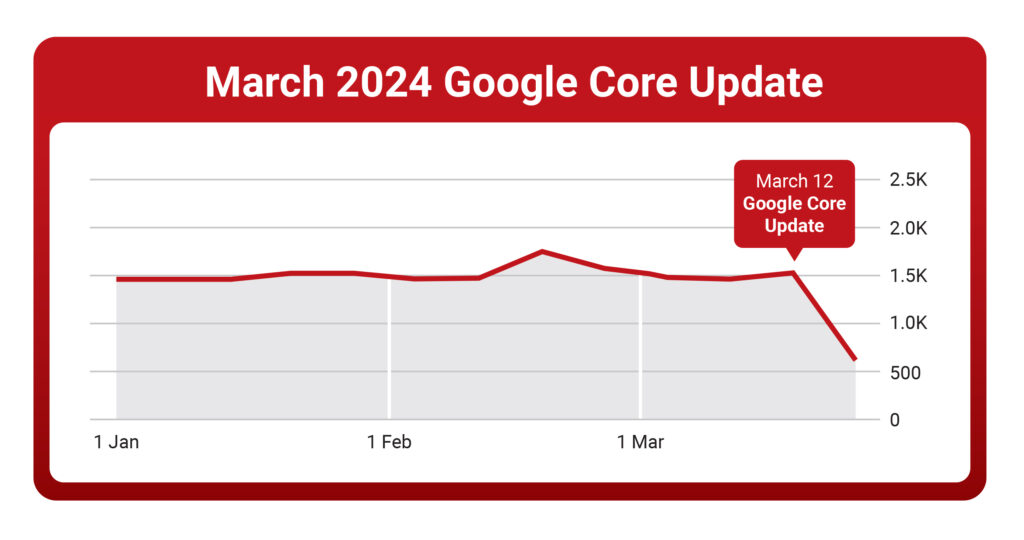Google’s AI-driven advancements will fundamentally reshape how marketers connect with audiences. Here’s your handy timeline of when new Google products will be available so you can future-proof your brand.
The era of AI-powered advertising has arrived, whether we are ready for it or not. To quote the great band of philosophers Pink Floyd: “Welcome to the machine. Where have you been? It’s all right. We know where you’ve been.” At Google Marketing Live on May 21, the tech giant unveiled a sweeping array of AI-driven advancements.
“A few years ago, the conversations were, ‘What is AI and how does it work?’ Last year, the question was, ‘Is this real?’ And now, every conversation is, ‘What can AI do for me and how can I actually implement it as fast as possible?’”
Phil Schindler, Vice President of Google Ads, during Google Marketing Live on May 21, 2024
So, what can AI do for you? That depends on which Google product or enhancement you are exploring! Google announced more than 30 new product launches and enhancements. Some are available already. Others, they plan to roll out over the next few weeks, months, or within the year. Naturally, these innovations are poised to fundamentally transform advertising as we know it.
The driving force behind Google’s sweeping changes is the integration of large language models and advanced AI capabilities across their entire marketing stack – search, display, shopping, and beyond. From intelligent ad creation and optimization to interactive, immersive ad experiences, AI will fundamentally reshape how we connect with audiences. As a forward-thinking marketer, it’s crucial to understand and prepare for the forthcoming AI-powered landscape.
The sheer number of announced updates can seem overwhelming, especially for organizations that may be grappling with the tools they currently have at their disposal. To make it easier, we’ve identified several themes across all the updates. We’ll dissect some of the immediate impacts, midterm strategies, and long-term vision, equipping you with insights to navigate this brave new world successfully. Whether you lead an internal team or collaborate with an agency partner, staying ahead of the curve is crucial.
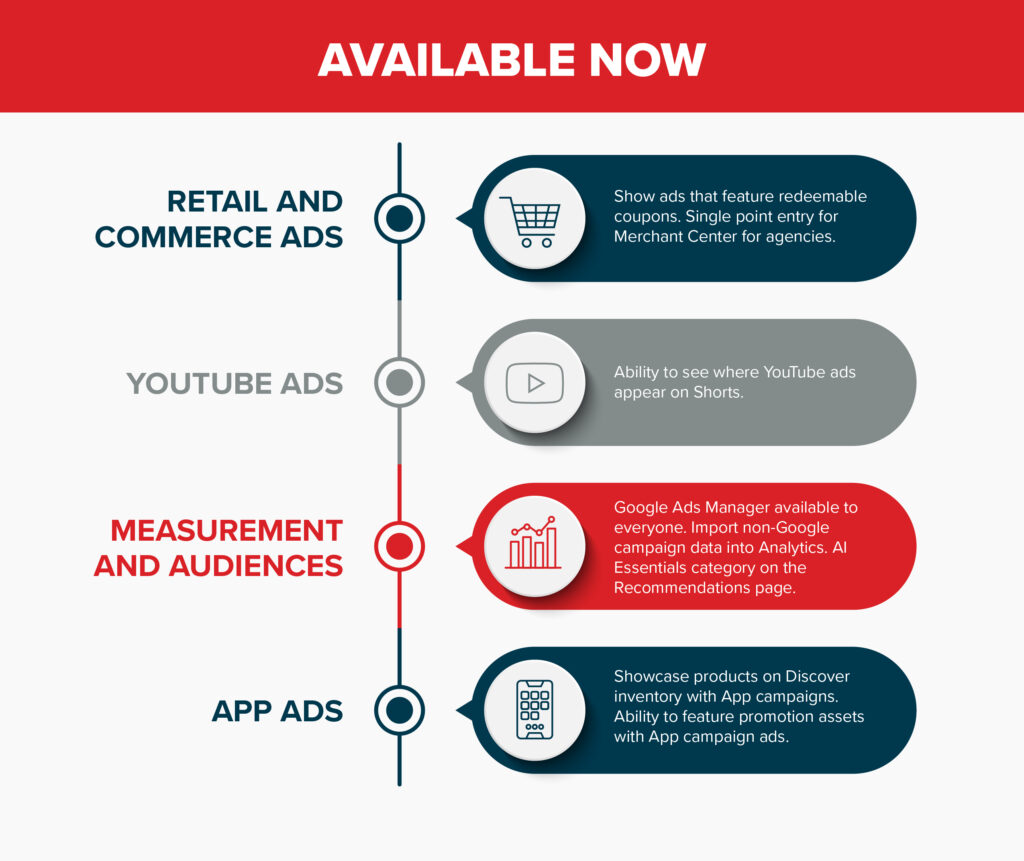
Google Products Available Now
- Retail and Commerce Ads
- Ability to show ads that feature redeemable coupons in Performance Max campaigns (available now, except in EU countries)
- Single point of entry in Merchant Center for agencies (available to select agencies now, rolling out to more later this year)
- YouTube Ads
- Ability to see where YouTube ads appear on Shorts
- Measurement and Audiences
- Google Ads Data Manager available to everyone
- Ability to import non-Google campaign data into Analytics
- New AI Essentials category on the Recommendations page
- App Ads
- Showcase products on Discover inventory with App campaigns
- Ability to feature promotion assets with App campaign ads
- Ability to link audience lists to App campaigns
- SKAdNetwork enhancements
- Ability to integrate SKAdNetwork conversion value schema with Google Ads
- Geo-based controlled experiments to measure incremental ROI
Available in the Coming Weeks
- Performance Max Ads
- Ability to add and remove objects, extend backgrounds, and adjust images for Performance Max
- Search Ads
- Search ads can now deliver interactive, AI-powered experiences
- Demand Gen Ads
- Animated image ads for Demand Gen campaigns on YouTube Shorts
- Ability to pin video assets to specific surfaces
- Lookalike segments with a minimum required list size of 100 users
- Retail and Commerce Ads
- Ad group feed filtering capabilities in the Google Ads UI
Available in the Coming Months
- Performance Max Ads
- Ability to easily collaborate across Google Ads and third-party creative platforms
- Improved image generation technology for Performance Max and Demand Gen campaigns
- Placement reporting for YouTube videos
- Asset-level reporting
- Conversion lift studies
- Search Ads
- Shopping ads will start showing at the top of visual search results when consumers use Google Lens or Circle to Search
- Search and Shopping ads in AI Overviews
- Demand Gen Ads
- Demand Gen campaigns will be rolling out to Display & Video 360 and Search Ads 360
- Retail and Commerce Ads
- Visual brand profile on Google Search
- Virtual try-on in Shopping ads
- 360-degree view in Shopping ads
- Profit optimization goal in Smart Bidding
- Ability to tailor promotions in Shopping ads for loyalty program members
- Actionable performance insights in Merchant Center Next with Google AI
- Automatic update bids in App campaigns based on promotional events
- YouTube Ads
- Stickers for Shorts ads
- Ability for viewers to swipe left to get to a landing page from Shorts ads or double tap to like
- Partnership ads powered by BrandConnect
- Measurement and Audiences
- Generated insights in Google Analytics
- Ability to use a simple prompt to filter data and build reports with visuals in Google Ads and Search Ads 360
- Measurement Diagnostics
- App Ads
- Web to App Connect for Video, Hotel, and Demand Gen ads
Google Products Available Later in 2024
- Performance Max Ads
- Ability for advertisers to provide Google AI with brand guidelines
- Experimentation to test the impact of adding more creative assets
- Revamped diagnostic insights
- Retail and Commerce Ads
- Product Studio will allow users to transform static photos into eye-catching videos
- Video highlights in Shopping ads
- Ability to feature new customer pricing in Shopping ads
- Dynamic sale pricing in Shopping ads
- Category-level performance insights and demand trends with competitive benchmarks
- YouTube Ads
- Expanded YouTube Shopping affiliate program
- Measurement and Audiences
- New customer acquisition goal with Google Analytics
- Cross-channel budgeting in Google Analytics
- Google-engaged audiences
- Meridian, an open source MMM, will roll out globally
- Ability to benchmark performance against similar businesses in Google Analytics 4
- Google Analytics 4 integration with linked Campaign Manager 360 accounts
Your Quick-Win Google Opportunities
That is a mind-meltingly extensive list. So, where do we begin? With so many new AI ad products spanning search, shopping, YouTube, and more rolling out, it’s critical to prioritize the biggest quick-win opportunities.
- Improved Audience Targeting. One of the headlining innovations is the expansion of audience targeting for Demand Gen ads. Marketers will soon be able to create lookalike audiences from lists as small as 100, down from the previous 1,000 minimum. This opens up opportunities to businesses of all sizes that previously couldn’t meet the large list requirement.
- Expanded Creative Capabilities. AI is also enhancing creative capabilities, with Performance Max ads gaining tools to modify images by adding/removing objects, extending backgrounds, and more. This allows for easy customization of creative assets on the fly. Demand Gen campaigns will also get animated image ads for YouTube Shorts.
- Better Reporting Analytics. Measurement is getting smarter too, with asset-level reporting coming for YouTube placement and the ability to import non-Google campaign data into Analytics for a true 360-degree view.
- Investment in Shopping Features. For ecommerce marketers, Google is turbocharging shopping ads with AI-powered visualization capabilities like 3D models that allow zooming and rotating products. The profit optimization smart bidding strategy will help maximize revenue. Shopping ads will even begin appearing in Google Lens visual search results.
- Adding Stickers for YouTube Shorts. The YouTube Shorts experience is also being enhanced for advertisers. Shorts ads will gain stickers to boost interactivity, while viewers can swipe or tap to visit a brand’s landing page directly from an ad. These features position it as a formidable rival to TikTok’s dominance of short-form video.

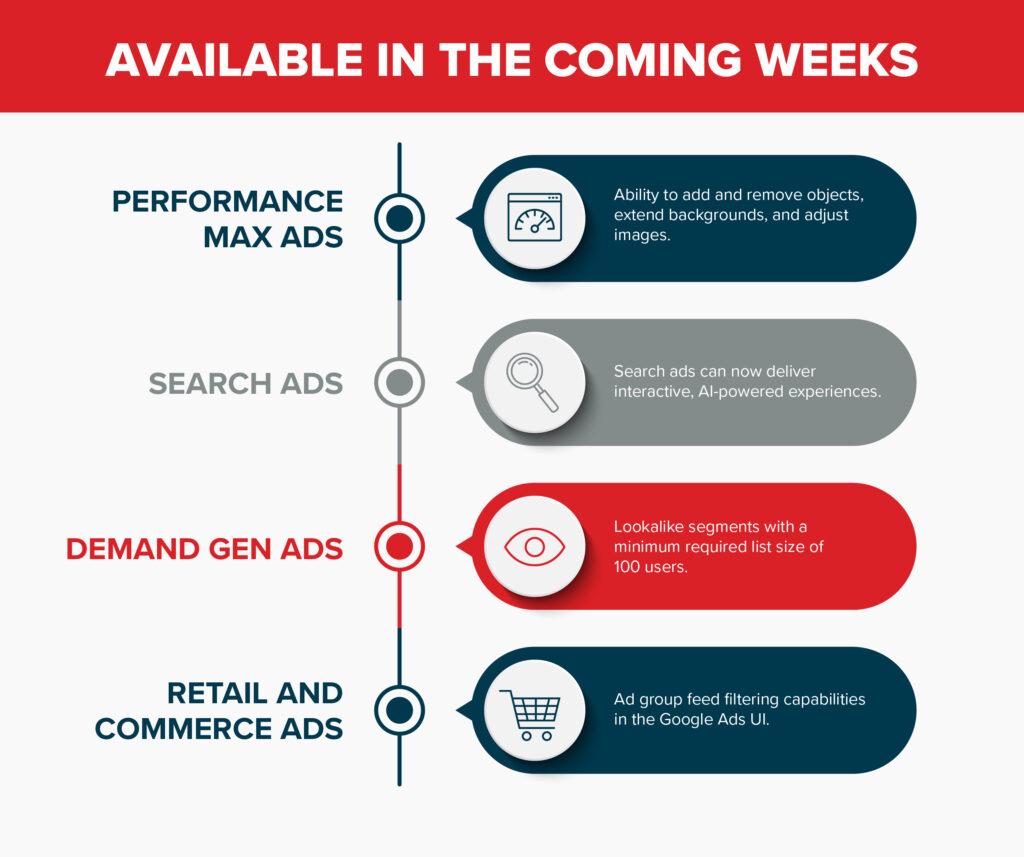
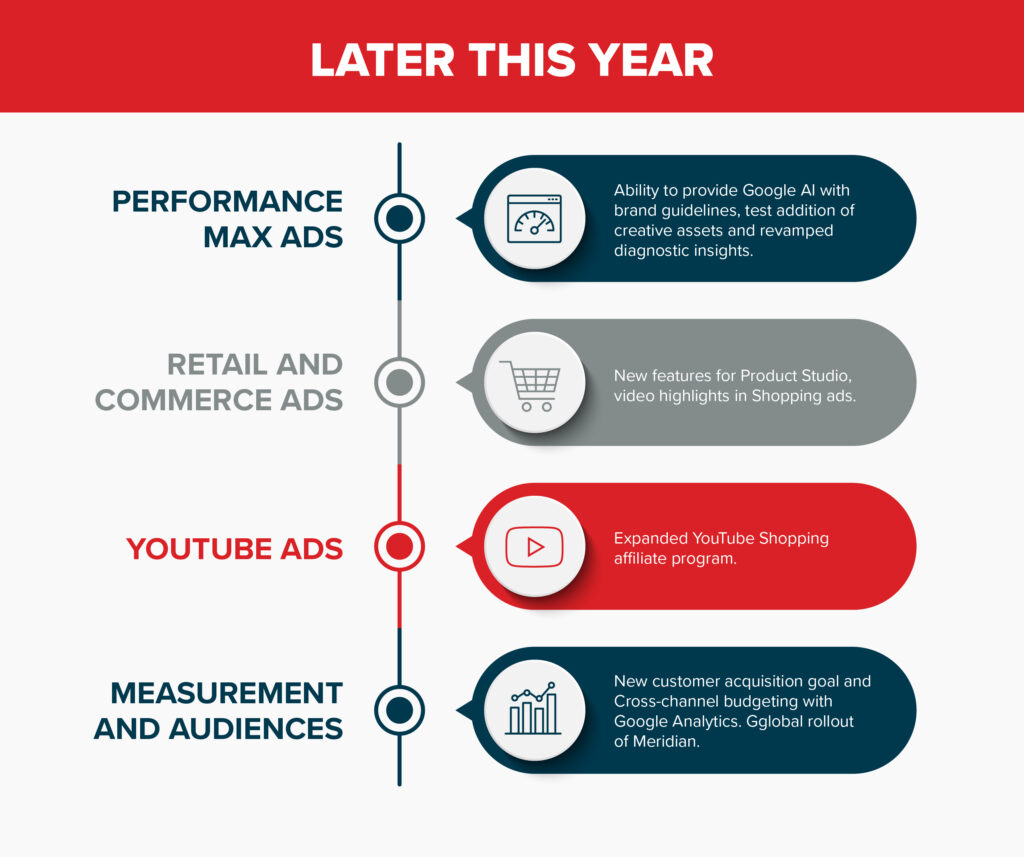
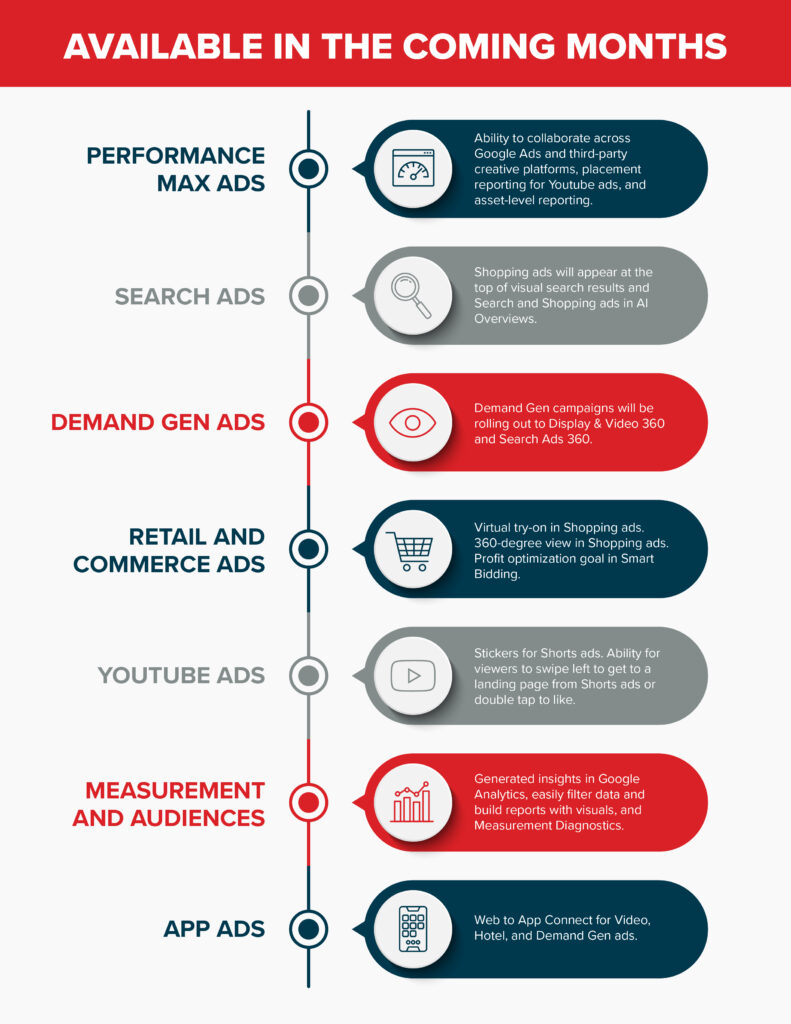
How Marketers Are Already Responding
For some marketers, Google’s announcement was met with cynicism. There are fears about being rendered obsolete as AI replaces human roles. Others feel a sense of being left behind by the sheer scale of changes and new skills required to keep pace. These concerns are understandable given our industry’s track record with overhyped trends that fizzled out like Web3.
However, viewing Google’s AI offensive through a lens of pessimism would be a costly mistake. The simple truth is that organizations that turn a blind eye and fail to embrace this AI-powered future will inevitably get lapped by competitors who do. Market share will shift toward those harnessing AI to deliver more personalized, visually interesting ad experiences.
This is not just another incremental advancement – it’s a seismic shift on par with the advent of websites, social media, and past defining moments in our industry’s evolution.
Imagine being able to instantly serve an ad for replacement barn siding just by someone uploading a photo of their damaged structure. Or having a clear bag ad populate for someone entering a venue where bags are checked. These are the kinds of powerful, precisely-targeted opportunities that AI visualization makes possible. And they merely scratch the surface of AI’s potential impact with better audience understanding, creative optimization, and so much more.
Your Marketing Strategy for Google in Q3 and Q4
So, how can marketers ensure they aren’t rendered obsolete by the AI revolution? The key is taking a proactive, pragmatic approach to upskilling and incorporating AI into your existing strategies and processes.
First, start by auditing your marketing calendar and planned initiatives for Q3 and Q4 of this year. Identify areas where you can begin layering in AI ad formats, visual assets, and the myriad other new AI-powered products Google is rolling out over the coming weeks and months. Don’t go overhauling everything at once. View this as a gradual process to slowly build experience and comfort working with these AI-enhanced capabilities.
Recognize that there will inevitably be some mistakes along the way, as Google itself demonstrated when its AI mistakenly suggested drinking urine to cure dehydration. That’s precisely why human oversight, strategy, and a phased adoption plan is so critical.
Regardless of whether you are a small business or a large one with your own marketing department, it’s important to realize Google’s announcement represents a paradigm shift. Do not be afraid to ask for help, or consulting from agencies on identifying opportunities to leverage Google’s new AI offerings effectively. By working with a knowledgeable partner, you accelerate your team’s AI maturity while mitigating risks like underutilized budget, inaccurate data, or brand safety issues that come with being an early AI-first mover.

